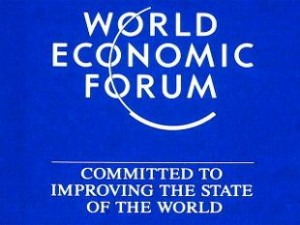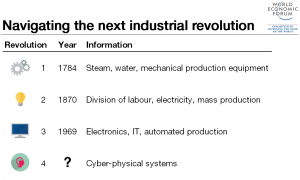 This book was written as the framework for the discussion at the World Economic Forum in Davos in January. Many scholars state that we are in the third industrial revolution. But Klaus Schwab, the founder of the WEF, states that because of the “Velocity: Contrary to the previous industrial revolutions, this one is evolving at an exponential rather than linear pace.” And that “Breadth and depth: It builds on the digital revolution and combines multiple technologies that are leading to unprecedented paradigm shifts in the economy, business, society, and individually. It is not only changing the “what” and the “how” of doing things but also “who” we are.” And lastly, “Systems Impact: It involves the transformation of entire systems, across (and within) countries, companies, industries and society as a whole.”
This book was written as the framework for the discussion at the World Economic Forum in Davos in January. Many scholars state that we are in the third industrial revolution. But Klaus Schwab, the founder of the WEF, states that because of the “Velocity: Contrary to the previous industrial revolutions, this one is evolving at an exponential rather than linear pace.” And that “Breadth and depth: It builds on the digital revolution and combines multiple technologies that are leading to unprecedented paradigm shifts in the economy, business, society, and individually. It is not only changing the “what” and the “how” of doing things but also “who” we are.” And lastly, “Systems Impact: It involves the transformation of entire systems, across (and within) countries, companies, industries and society as a whole.”
The book is a quick read, but never the less provocative in the subjects covered. He discusses the drivers behind this revolution as well as the megatrends such as physical, digital and biological. Some of the tipping points he predicts that will happen before 2025 include both the first car and implanted liver created by a 3D Printer, a government that uses big data instead of a census and one trillion sensors connected to the internet. He gives a percent probability to his list including a 45.2 % chance of an Artificial Intelligence machine on a corporate board of directors!
The majority of the book is covered in Chapter Three titled “Impact.” For me, this was fascinating. Topics such as the economy, employment, productivity, aging, the nature of work and labor substation is covered in the first section.
When he addresses business specifically, Environmental Renewal and Preservation is highlighted. “At the heart of this promise is the opportunity to shift businesses and consumers away from the linear take-make-dispose model of resource use, which relies on large quantities of easily accessible resources, and towards a new industrial model where effective flows of materials, energy, labor and now information interact with each other and promote by design a restorative, regenerative and more productive economic system.”
“One of the biggest impacts will likely result from a single force: empowerment – how governments relate to their citizens; how enterprises relate to their employees, shareholders and customers; or how superpowers relate to smaller countries. The disruption that the fourth industrial revolution will have on existing political, economic and social models will therefore require that empowered actors recognize that they are part of a distributed power system that requires more collaborative forms of interaction to succeed.”
 He ends with “The Way Forward: The fourth industrial revolution may be driving disruption, but the challenges it presents are of our own making. It is thus in our power to address them and enact the changes and policies needed to adapt (and flourish) in our emerging new environment. We can only meaningfully address these challenges if we mobilize the collective wisdom of our minds, hearts and souls.” His final paragraph: “We can go even further. I firmly believe that the new technology age, if shaped in a responsive and responsible way, could catalyze a new cultural renaissance that will enable us to feel part of something much larger than ourselves – a true global civilization. The fourth industrial revolution has the potential to robotize humanity, and thus compromise our traditional sources of meaning – work, community, family, identity. Or we can use the fourth industrial revolution to lift humanity into a new collective and moral consciousness based on a shared sense of destiny. It is incumbent on us all to make sure that the latter is what happens.”
He ends with “The Way Forward: The fourth industrial revolution may be driving disruption, but the challenges it presents are of our own making. It is thus in our power to address them and enact the changes and policies needed to adapt (and flourish) in our emerging new environment. We can only meaningfully address these challenges if we mobilize the collective wisdom of our minds, hearts and souls.” His final paragraph: “We can go even further. I firmly believe that the new technology age, if shaped in a responsive and responsible way, could catalyze a new cultural renaissance that will enable us to feel part of something much larger than ourselves – a true global civilization. The fourth industrial revolution has the potential to robotize humanity, and thus compromise our traditional sources of meaning – work, community, family, identity. Or we can use the fourth industrial revolution to lift humanity into a new collective and moral consciousness based on a shared sense of destiny. It is incumbent on us all to make sure that the latter is what happens.”
I found his perspective to be balanced and realistic. He addresses the challenges head on and that we need to take responsibility for our actions going forward. While pointing out a variety of paths that civilization could take, overall he paints a positive outlook that people guided by “doing the right thing” will lead us down the best path to a bright future.
